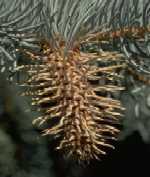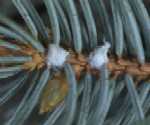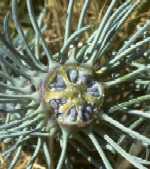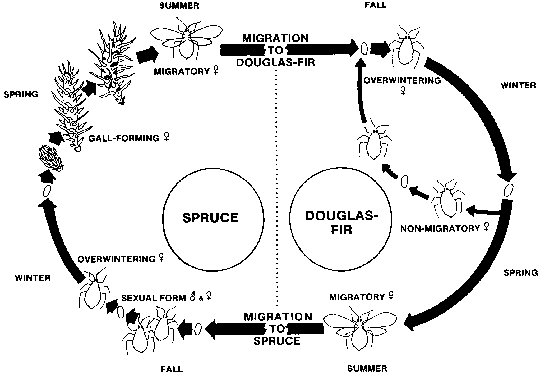by W.S. Cranshaw* (6/13)
Quick Facts…
- Cooley spruce galls are common and conspicuous on blue spruce. However, they do little or no harm to the tree.
- The galls are produced by aphid-like insects, Cooley spruce gall adelgids.
- Cooley spruce gall adelgids require two hosts to complete their normal life cycle: spruce and Douglas-fir.
- Once the galls begin to form, insecticides usually are ineffective because the insects are protected within the galls.
- The best times to spray are in the spring before new growth starts or in the fall when overwintering stages of the insect have returned to the tree.
 |
Figure 1: Gall on blue spruce. |
Cooley spruce galls are commonly found on the new growth of spruce trees. These galls are produced by insects called Cooley spruce gall adelgids (woolly aphids). Galls appear early in the season as 2- to 4-inch cucumber-shaped growths. The galls are light green during late spring and early summer but dry out and become brown starting in mid-July. The galls often are mistaken for seed cones.
Cooley spruce galls are conspicuous and frequently cause considerable concern to homeowners. However, the galls usually do not cause any serious harm to the tree.
Extremely heavy infestations may cause minor retardation of tree growth and some distortion. However, in most cases, old galls are covered by new growth the following season and become almost unnoticeable a few years after they form.
Life Cycle
Cooley spruce gall adelgids normally require two hosts (Douglas-fir and spruce) to complete their entire life cycle (Figure 4). Alternating between these plants, the life cycle often takes a year to complete. On spruce, woolly aphids overwinter as immature females underneath young branches. In the spring, females mature and lay several hundred eggs near developing buds. Eggs hatch at about the time of bud break and young nymphs migrate to the new spring growth. There they feed at the base of growing needles. Saliva introduced into the plant causes changes in plant development and produces galls.
The insects develop within chambers inside the galls and gradually increase in size. During the period when the insects are actively feeding, the galls stay green and are not readily observed. By midsummer, the galls dry out, the chambers open and winged forms of the insects emerge. These winged forms leave the original tree and most migrate to Douglas-fir trees. The abandoned galls continue to dry out and become increasingly noticeable a few weeks after the insects leave.
On Douglas-fir, eggs are laid on the needles and several generations of woolly aphids are produced. Yellow spots and bent needles result from feeding damage. The trees appear speckled with tiny cotton-like forms of the insect. No galls are produced on Douglas-fir. Late in the summer, some of the woolly aphids develop wings and fly back to spruce to deposit eggs, which produce the overwintering population. Others are wingless and remain on Douglas-fir trees, where they produce other overwintering forms.
 |
Figure 2: Overwintered females. |
 |
Figure 3: Gall cross-section showing developing insects. |
Certain patterns of infestation are commonly observed on spruce. Most galling typically takes place on the more shaded sides of trees (north, east). Also, individual trees appear to vary greatly in their susceptibility to galling. Some trees, usually those that have a greener coloration, tend to be more heavily infested than other trees. This suggests that resistance to galling is a widespread characteristic among spruce trees.
Control
Control of Cooley spruce gall is rarely needed to protect tree health. Infestations of this insect are highly cyclical, with their numbers often changing greatly from season to season. However, insects may be controlled to prevent aesthetic injuries that can detract from tree appearance.
Control must occur before galls begin to form. Apply treatments in fall, after the overwintering females have settled on the plants, or, most commonly, in spring. Spring applications are most effective if made before the insects have begun to swell with eggs, which typically occurs in late April.
Foliar treatments of carbaryl (Sevin) and permethrin have been most effective in Colorado State University trials. Horticultural oils have also been very effective can cause temporary discoloration of spruce needles. See fact sheet 5.569, Insect Control: Horticultural Oils. Insecticidal soaps are only moderately effective on spruce, but are used widely to control this insect on Douglas-fir. Direct all foliar applications at the underside of spruce terminals where the overwintering aphids are concentrated.
Soil injections of imidacloprid can control Cooley spruce gall adelgids. However, the treatments often fail to kill many of the insects until after the galls are formed. These galls usually remain green rather than browning in early summer. Fall applications are recommended for this insect.
Removal of old galls will not affect infestations because the insects have left the tree by the time galls turn brown and become conspicuous. Old galls are not later used by any stages of this insect.
When establishing plantings, avoid placing Douglas-fir and spruce close together.
 |
Figure 4: Life cycle of the Cooley spruce gall adelgid. Research indicates that the adelgids leaving spruce must develop on Douglas-fir before returning to spruce. Observations in Colorado suggest that spruce to spruce movement also may occur. |
Table 1: insecticides for control of Cooley spruce gall adelgids.
Always read and follow mixing and usage instructions on the label. Direct applications against the overwintering insect, preferably before egg production has begun. Treatments usually are best made during warm periods in fall (mid-October or November) or in late March through April. |
* Colorado State University Extension entomologist and professor, bioagricultural sciences and pest management. 11/98. Revised 6/13.
Colorado State University, U.S. Department of Agriculture, and Colorado counties cooperating. CSU Extension programs are available to all without discrimination. No endorsement of products mentioned is intended nor is criticism implied of products not mentioned.
Go to top of this page.





